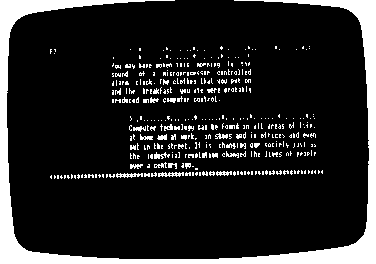You may want the next paragraph to have a different ruler setting, in which
case a new ruler must be added to the document. You can do this by pressing:
![]() + f5 (RULER)
+ f5 (RULER)
to put a standard ruler in the required position, then editing the ruler as
appropriate. Sometimes it may be more convenient to copy the current ruler
and edit that -- pressing ![]() +
+
![]() together will generate a copy of the
together will generate a copy of the
current ruler at the current cursor position. Having created your new ruler,
any text typed in below it will be subject to the new margin setting, as shown
below.

VIEW recognises a ruler by the two dots in the left margin. They are normally
followed by a line of dots and asterisks bounded by margin stops > and <. The
left margin stop is omitted on standard rulers. With two exceptions, the
characters that appear between the margin stops > and < are irrelevant so it
makes sense to adopt the convention of using a line of dots as this renders the
ruler immediately recognisable to the user.
The asterisks in standard rulers are TAB stops. Their function can best be
illustrated by putting the cursor on a blank line then pressing the ![]() key
key
two or three times. The cursor jumps from one TAB position to the next. This
facility is particularly useful in constructing tables. Having used ![]() to move
to move
the cursor across the screen, the effect of pressing ![]() may surprise you.
may surprise you.
Instead of moving by one character position at a time, the cursor jumps back
from each TAB stop to the next. This effect is less surprising when you realise
that TAB is, in fact, an invisible character. Cursor movement, therefore, by
D 14